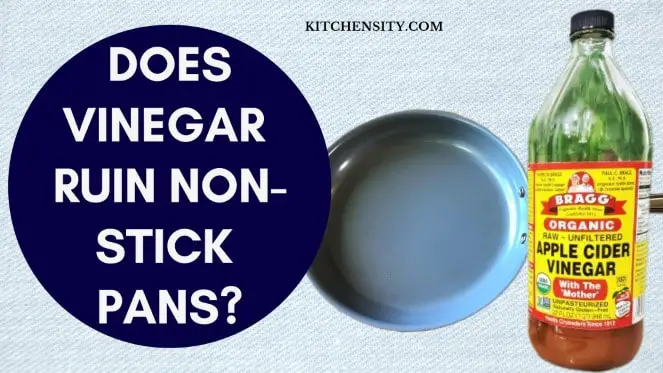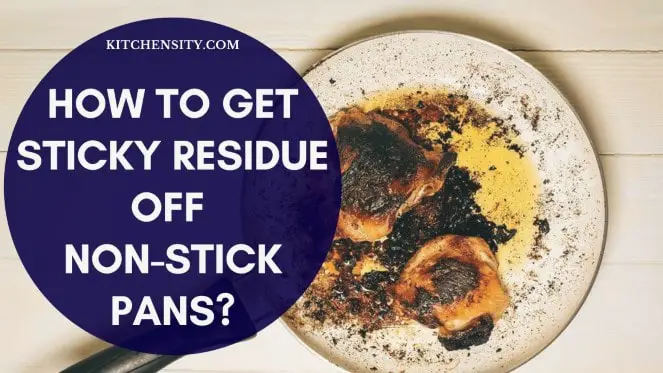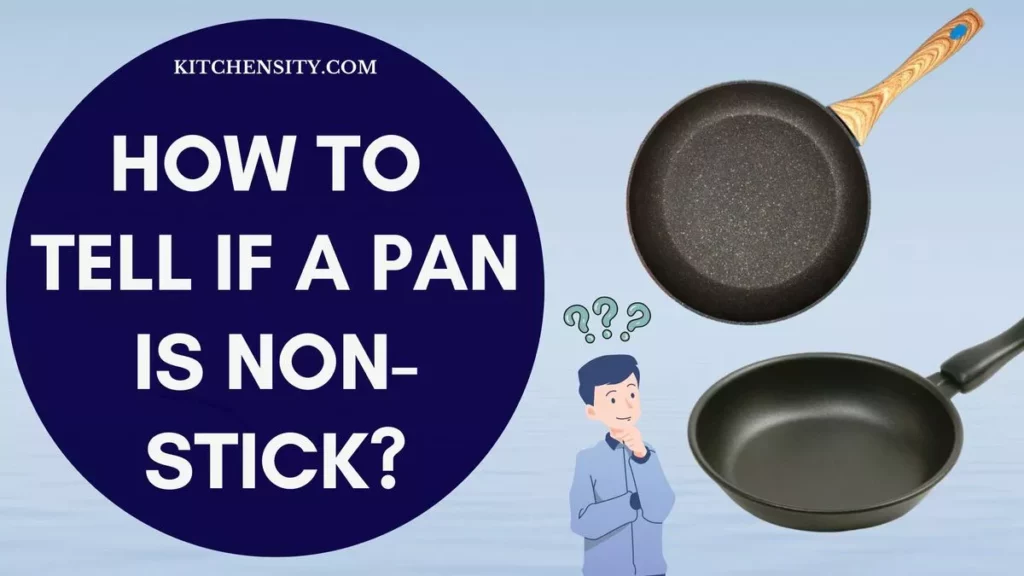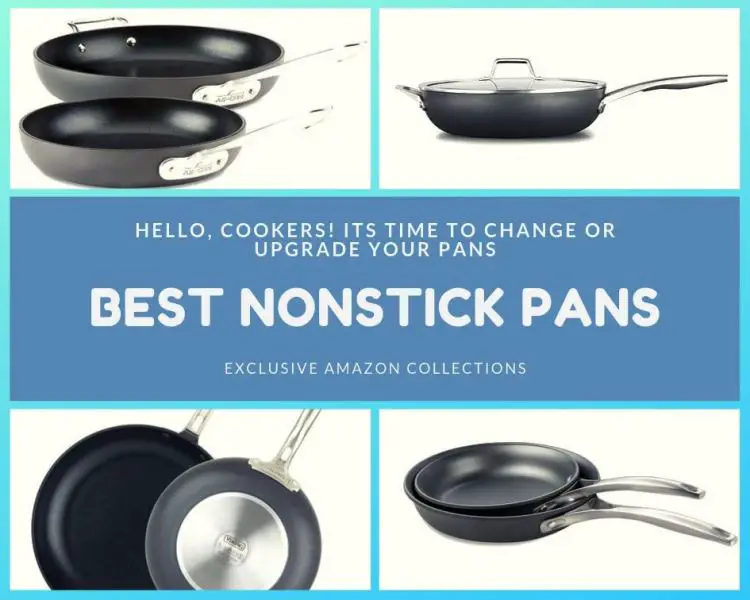Non-stick cookware is a common kitchen convenience, but its production and use can have notable environmental impacts. In this article, I’ll discuss the environmental effects of non-stick cookware, focusing on the popular coating Teflon (PTFE) and its alternatives.
We’ll explore why Teflon became popular, its environmental drawbacks, and the emergence of eco-friendly options. We’ll also look at perfluoroalkyl substances (PFAS), like perfluorooctanoic acid (PFOA), in non-stick coatings and their potential environmental and health effects.
Table of Contents
- 1 What Are The Impacts Of Non-Stick Cookware On The Environment?
- 2 What Is Teflon Or PTFE?
- 3 Alternatives To Teflon For Environmental Benefit.
- 4 Exploring Teflon Sheets And Its Uses.
- 5 What Are PFAS?
- 6 PTFE And PFOA In Non-Stick Cookware
- 7 Is Non-Stick Pan Toxic?
- 8 Proper Disposal Methods For Teflon Pans.
- 9 Industry Efforts To Reduce Environmental Impact.
- 10 Final Thoughts: Environmental Impact Of Non-Stick Cookware
- 11 Frequently Asked Questions (FAQs)
What Are The Impacts Of Non-Stick Cookware On The Environment?
The environmental impact of non-stick cookware extends beyond its immediate use in kitchens. From the production phase to disposal, non-stick cookware can affect various aspects of society and the environment.
- Production Process: The production of non-stick cookware, especially those with PTFE coatings like Teflon, involves the use of various chemicals and energy-intensive processes, contributing to pollution and greenhouse gas emissions.
- Chemical Disposal: Disposing of non-stick cookware, particularly if it’s scratched or damaged, can release harmful chemicals into the environment. PTFE coatings can break down into perfluorooctanoic acid (PFOA) and other perfluoroalkyl substances (PFAS), which are persistent and can accumulate in the environment.
- Landfill Waste: Non-stick cookware has a limited lifespan and eventually ends up in landfills. The disposal of these products adds to the overall waste problem, as non-stick coatings are not easily biodegradable.
- Resource Depletion: The production of non-stick cookware requires raw materials such as metals and chemicals. The extraction and processing of these materials can lead to habitat destruction, deforestation, and other environmental impacts.
- Health Concerns: While not directly related to the environment, the health concerns associated with non-stick cookware can indirectly impact the environment. For example, if consumers choose to dispose of their non-stick cookware due to health worries, it adds to the waste stream.
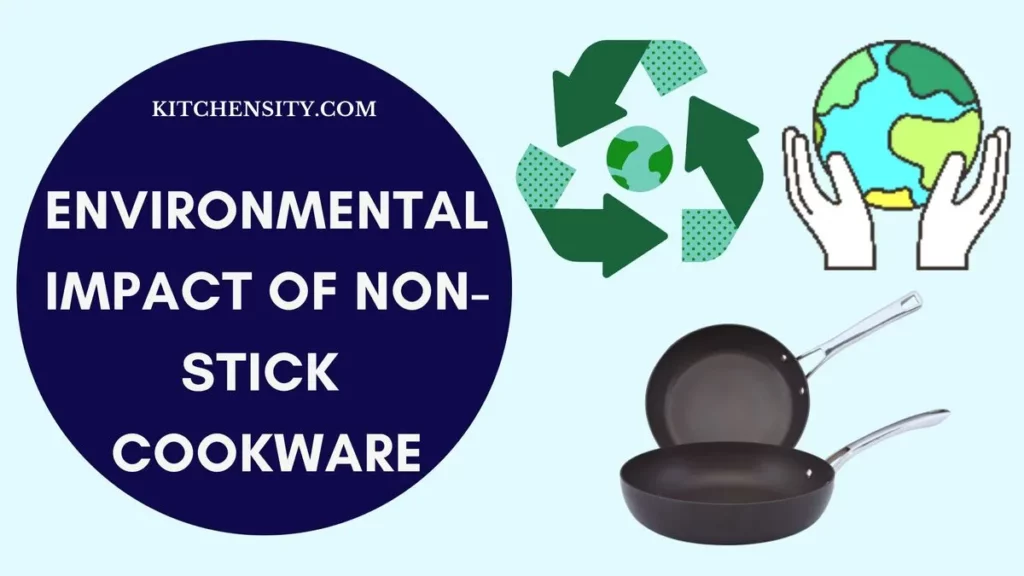
Also Read – Best Non-Stick Cookware Brands
How To mitigate these environmental impacts?
To mitigate the environmental impacts of non-stick cookware, several steps can be taken. Firstly, opting for cookware made from eco-friendly materials such as ceramic, cast iron, stainless steel, or glass can significantly reduce environmental footprints. These materials are more durable and have lower environmental impacts compared to non-stick coatings. Secondly, using non-stick cookware responsibly can extend its lifespan. Avoiding the use of metal utensils that can scratch the coating and hand washing the cookware instead of using a dishwasher can prevent premature wear. Also, cooking at lower temperatures can help prolong the life of non-stick coatings.
When disposing of non-stick cookware, it is important to recycle responsibly. Checking with local recycling facilities to see if they accept non-stick cookware can reduce the amount of waste sent to landfills. Choosing non-stick cookware labeled as PFOA-free can also help mitigate environmental impacts. While PTFE coatings like Teflon are still used, PFOA is a harmful chemical that has been phased out of production in many countries.
Repairing non-stick cookware instead of replacing it can also be beneficial. Some companies offer services to recoat or restore non-stick surfaces, extending their usable life. Also, supporting sustainable brands that prioritize sustainability in their manufacturing processes and use of materials can make a positive impact.
What Is Teflon Or PTFE?
Teflon is a type of fluoropolymer that consists of carbon and fluorine atoms arranged in a specific molecular structure, which gives it its non-stick and heat-resistant properties. It is known for its high chemical resistance, low friction, and non-reactive nature, making it suitable for a wide range of industrial and consumer applications.
It was first discovered in 1938 by a chemist at DuPont, and its unique properties quickly made it popular for various applications, including non-stick coatings for cookware.
Why Is Teflon Preferred Over Alternatives?
Teflon is preferred over alternatives because of its exceptional non-stick properties, which allow for easy cooking and cleaning. Unlike traditional cooking surfaces, Teflon-coated cookware requires minimal oil or fat for cooking, making it a healthier option for many consumers.
- Teflon’s non-stick properties make it highly desirable for cookware, as it allows for easy release of food without the need for excess oils or fats.
- Its heat resistance also makes it suitable for use in high-temperature cooking applications, where other materials might degrade or release harmful fumes.
- Compared to some alternatives, Teflon is relatively durable and can withstand repeated use without significant degradation of its non-stick properties.
Also Read – Latest Advancements In Non-Stick Pans
Do Non-Stick Pans Still Have Teflon?
Yes, some non-stick pans still use Teflon (polytetrafluoroethylene or PTFE) as the coating material. Teflon is known for its excellent non-stick properties, which is why it has been widely used in cookware for many years.
But, due to growing concerns about Teflon’s environmental and health impacts and related chemicals, some manufacturers have started exploring alternative coatings. These alternatives provide similar non-stick performance while addressing the potential drawbacks of Teflon, such as releasing harmful fumes at high temperatures and the environmental persistence of its components. As a result, now you have a wider range of non-stick cookware options to choose from, including those that do not use Teflon.
What Are The Applications Of Teflon?
Teflon has a wide range of applications due to its unique properties. Some of the common applications are:
- Due to its excellent non-stick properties, Teflon is widely used as a non-stick coating for pots, pans, and other cookware.
- It is also used as a coating for industrial equipment and machinery to reduce friction, prevent corrosion, and provide chemical resistance.
- Teflon is used as an electrical insulator in wires, cables, and electronic components due to its high dielectric strength and resistance to heat and chemicals.
- Due to its chemical resistance and low friction properties, it is used to make seals and gaskets for various applications, including in automotive, aerospace, and industrial settings.
- Due to its biocompatibility and chemical inertness, it is also used in the medical field for applications such as catheters, tubing, and surgical implants.
- Teflon is used to coat fabrics and textiles to make them water and stain-resistant and it is also used in automotive applications, such as in bearings and seals, due to its low friction properties.
Also Read – Do Chefs Use Non-Stick Cookware?
Alternatives To Teflon For Environmental Benefit.
There are several alternatives to Teflon that offer environmental benefits. Some of these alternatives include:
- Ceramic Coatings: Ceramic coatings are made from inorganic materials and are considered more environmentally friendly than Teflon. They offer similar non-stick properties and are less likely to emit harmful chemicals when overheated.
- Cast Iron: Cast iron cookware is durable, retains heat well, and can be naturally non-stick when properly seasoned. It does not require the use of synthetic coatings and can last for generations with proper care.
- Stainless Steel: Stainless steel cookware is durable, resistant to rust and corrosion, and does not require a non-stick coating. It is a more environmentally friendly option than Teflon-coated cookware.
- Carbon Steel: Carbon steel cookware is similar to cast iron but lighter and easier to handle. It can develop a natural non-stick surface over time with proper seasoning and care.
- Glass: Glass cookware is non-reactive, easy to clean, and does not require a non-stick coating. It is a safe and environmentally friendly option for cooking and baking.
- Anodized Aluminum: Anodized aluminum cookware is treated with an electrochemical process that creates a durable, non-stick surface. This process also makes the aluminum more resistant to corrosion and scratching, resulting in a longer lifespan for the cookware.
Also Read – What Recipes Work Best With Non-Stick Pans?
What Are The Benefits Of Teflon’s Alternatives?
The development and use of alternative non-stick coatings offer several environmental benefits compared to traditional coatings like Teflon. Some key environmental benefits are:
- Many alternatives, such as ceramic coatings, cast iron, and stainless steel, are more environmentally friendly than Teflon. They do not release harmful chemicals into the environment during production or use.
- Some alternatives, like cast iron and stainless steel, are highly durable and can last for many years with proper care. This reduces the need for frequent replacement, which can be more sustainable in the long run.
- Cast iron and carbon steel develop natural non-stick properties over time with proper seasoning and use. This eliminates the need for synthetic non-stick coatings and reduces the risk of harmful chemical exposure.
- Alternatives like stainless steel and glass are versatile and can be used for a wide range of cooking methods, including stovetop, oven, and even induction cooking.
- Some alternatives, such as cast iron, can add trace amounts of iron to food, which can be beneficial for those with iron deficiencies.
- Alternative coatings may use materials that are more abundant or easier to source sustainably, reducing the pressure on natural resources.
Also Read – How To Care For Non-Stick Pans When Used Outdoors?
Exploring Teflon Sheets And Its Uses.
Teflon sheets or PTFE sheets, are versatile materials that find applications in various industries due to their unique properties. These sheets are made from polytetrafluoroethylene (PTFE), the same material used in non-stick cookware coatings. Teflon sheets are known for their non-stick, heat-resistant, and chemical-resistant properties, making them suitable for a wide range of uses.
- Teflon sheets are thin sheets made from PTFE that exhibit non-stick properties similar to those of Teflon coatings.
- These sheets are used in applications where a non-stick surface is required, such as in baking and cooking, where they can be used as a non-stick liner for baking trays and oven racks.
- In industrial settings, Teflon sheets are used as release liners in manufacturing processes where materials need to be easily removed from molds or other surfaces.
- Teflon sheets are also used in packaging applications, where their non-stick properties help prevent adhesion between layers of materials.
Also Read – How To Use A Non-Stick Pan For The First Time?
What Are The Alternatives To Teflon Sheets?
Many alternatives to Teflon sheets are being explored to address potential environmental concerns and offer alternatives with different properties. These alternatives include:
- Silicone Baking Mats: Silicone baking mats are non-stick mats made from food-grade silicone that can be used as a substitute for Teflon sheets in baking applications. They are reusable, easy to clean, and can withstand high temperatures, making them a popular choice for baking enthusiasts.
- Parchment Paper: Parchment paper is a cellulose-based paper that has been treated with silicone or other non-stick coatings. It is commonly used in baking as a non-stick surface and can be used as an alternative to Teflon sheets for lining baking trays and pans.
- Reusable Silicone Storage Bags: Silicone storage bags are a sustainable alternative to single-use plastic bags for food storage. They are made from food-grade silicone and can be used for storing and freezing food items without the need for disposable plastic bags.
- Natural Fiber Mats: Mats made from natural fibers such as silicone or bamboo are also being explored as alternatives to Teflon sheets. These mats are biodegradable and can be used in various applications where a non-stick surface is needed.
- Recycled Paper-based Coatings: Some companies are developing non-stick coatings made from recycled paper and other natural materials. These coatings offer non-stick properties while being more environmentally friendly than traditional Teflon coatings.
- Biodegradable Films: Biodegradable films made from natural polymers such as starch or cellulose are being researched as alternatives to Teflon sheets in packaging and other applications. These films are designed to degrade more readily in the environment, reducing their long-term impact.
- Bio-based Polymers: Bio-based polymers derived from renewable sources such as plants or algae are being used to develop non-stick coatings and films as alternatives to Teflon. These materials offer the potential for reduced environmental impact compared to petroleum-based polymers.
Also Read – Are Non-Stick Coatings Safe For Cooking?
What Are PFAS?
PFAS is a group of synthetic chemicals that contain fluorine atoms bonded to carbon atoms. This bond is one of the strongest in organic chemistry, giving PFAS their unique properties such as resistance to heat, water, and oil. It has been used in a wide range of products, including non-stick cookware, food packaging, firefighting foams, and stain-resistant fabrics, due to their ability to repel water and oil.
PFAS have been used in the production of non-stick coatings, including Teflon (polytetrafluoroethylene or PTFE), to provide the non-stick properties that these coatings are known for.
Presence Of PFAS In Non-Stick Cookware.
The presence of PFAS (per- and polyfluoroalkyl substances) in non-stick cookware has raised concerns about potential exposure to these chemicals during cooking. When non-stick cookware is heated, especially at high temperatures, there is a potential for the release of PFAS compounds into the air and food. While the amount of PFAS released during normal cooking is generally considered to be low, there is ongoing research to better understand the extent of this exposure and its potential health effects.
In response to these concerns, regulatory agencies have implemented measures to limit the use of certain PFAS compounds in consumer products, including non-stick cookware. Manufacturers have also been working to develop alternative non-stick coatings that do not rely on PFAS, aiming to provide consumers with options that meet their needs for non-stick performance while minimizing potential health and environmental risks associated with PFAS.
Also Read – Types Of Non-Stick Coatings
PFAS Contamination And Chemicals.
The contamination of water, soil, and air with PFAS has occurred primarily through industrial releases, the use of firefighting foams containing PFAS, and the disposal of consumer products containing these chemicals. Once released into the environment, PFAS can persist for long periods without breaking down, leading to their accumulation in the environment and the food chain.
The potential health effects of PFAS exposure have raised concerns among scientists, regulators, and the public. Studies have linked PFAS exposure to a range of adverse health effects in humans, including developmental effects in fetuses and infants, effects on the immune system, increased cholesterol levels, and an increased risk of certain cancers. Due to these concerns, regulatory agencies around the world have been taking action to address PFAS contamination and limit human exposure to these chemicals.
Efforts to mitigate PFAS contamination include monitoring and testing for PFAS in water supplies, developing remediation technologies to remove PFAS from contaminated sites, and implementing regulations to limit the use and release of PFAS into the environment. Also, there is ongoing research into alternative non-toxic chemicals and materials that can replace PFAS in various applications to reduce environmental and health risks.
Risks And Concerns Related To PFAS.
- PFAS are highly resistant to degradation in the environment, leading to concerns about their long-term impact on ecosystems and wildlife.
- Some PFAS compounds have been associated with adverse health effects in humans, including developmental effects, liver toxicity, immune system disruption, and an increased risk of certain cancers.
- PFAS can accumulate in the environment and the food chain, leading to higher concentrations in organisms at the top of the food chain, including humans.
- Due to these concerns, there has been increasing regulation of PFAS compounds, with some countries and regions phasing out certain PFAS compounds and imposing stricter limits on their use and presence in consumer products.
Also Read – How To Extend The Lifespan Of Non-Stick Pans?
PTFE And PFOA In Non-Stick Cookware
Explanation Of PTFE And PFOA.
- PTFE (polytetrafluoroethylene) is a synthetic fluoropolymer that is widely used in non-stick coatings for cookware due to its excellent non-stick and heat-resistant properties.
- PFOA (perfluorooctanoic acid) is a synthetic chemical that was historically used in the production of PTFE and other fluoropolymer-based products to aid in the manufacturing process. PFOA is classified as a persistent organic pollutant (POP) and is known for its environmental persistence and potential health effects.
Historical Use Of PFOA In Teflon Production.
- PFOA was historically used in the production of PTFE-based products, including Teflon, to help with the processing of the polymer and the formation of the non-stick coating.
- During the manufacturing process, PFOA was used as a surfactant to aid in the dispersion of PTFE particles and as a processing aid to improve the properties of the final product.
- Concerns about the environmental and health impacts of PFOA led to increased scrutiny of its use in manufacturing processes and its presence in consumer products.
Current Regulations Regarding PFOA.
- Due to concerns about the environmental persistence and potential health effects of PFOA, regulatory agencies around the world have taken steps to restrict its use and minimize human exposure.
- In the United States, the Environmental Protection Agency (EPA) has worked with industry to voluntarily phase out the use of PFOA and related chemicals in the production of PTFE-based products, including non-stick cookware.
- The use of PFOA has been largely phased out in the production of Teflon and other non-stick coatings, with manufacturers using alternative processing aids and surfactants to achieve the desired properties of the coatings.
- Regulations in other countries and regions, such as the European Union, have also imposed restrictions on the use of PFOA and related chemicals in consumer products, including cookware, to protect human health and the environment.
Difference Between PTFE & PFOA.
PTFE (polytetrafluoroethylene) and PFOA (perfluorooctanoic acid) are two distinct chemicals used in the production of non-stick cookware, but they serve different purposes and have different properties.
- PTFE (Polytetrafluoroethylene):
- Purpose: PTFE is the primary component of non-stick coatings used in cookware. It provides non-stick properties that make it easier to cook with and clean the cookware.
- Properties: PTFE is a synthetic fluoropolymer known for its high heat resistance, low friction, and non-stick properties. It is chemically inert, meaning it does not react with other chemicals, and it is not biodegradable.
- Use: PTFE is widely used in cookware coatings, including brands like Teflon, due to its ability to create a smooth, non-stick surface that is easy to clean.
- PFOA (Perfluorooctanoic Acid):
- Purpose: PFOA is not a component of non-stick coatings itself but has historically been used as a processing aid in the production of PTFE and other fluoropolymer-based products.
- Properties: PFOA is a synthetic chemical that has been classified as a persistent organic pollutant (POP). It is known for its environmental persistence and potential health effects, including being linked to certain health issues in studies.
- Use: PFOA was used in the past to aid in the manufacturing process of PTFE-based products, including non-stick coatings, but its use has been phased out in many jurisdictions due to environmental and health concerns.
Also Read – Can You Deep Fry In A Non-Stick Pan?
Is Non-Stick Pan Toxic?
Non-stick pans are generally considered safe for cooking when used properly. But, at very high temperatures (above 500°F or 260°C), non-stick coatings can break down and release fumes that may contain toxic substances, such as perfluorooctanoic acid (PFOA) and perfluorooctane sulfonate (PFOS). Inhaling these fumes can lead to polymer fume fever, a temporary flu-like illness.
While modern non-stick coatings are designed to be stable and safe under normal cooking conditions, it is important to use non-stick pans within their recommended temperature range and avoid overheating to minimize any potential risks.
What Makes Non-Stick Pans Toxic?
Non-stick pans can be toxic if they are overheated or damaged, causing the non-stick coating to break down and release harmful chemicals into the air and food. The primary concern with non-stick pans is the potential release of perfluorooctanoic acid (PFOA) and other per- and polyfluoroalkyl substances (PFAS) when the pans are overheated.
When non-stick pans are heated to high temperatures (above 500°F or 260°C), the non-stick coating can start to degrade, releasing toxic fumes. These fumes can contain PFOA, which has been linked to various health issues, including cancer, thyroid disease, and developmental problems.
In addition to PFOA, other PFAS chemicals used in non-stick coatings have been associated with similar health risks. While many manufacturers have phased out the use of PFOA and other harmful chemicals in their non-stick coatings, there is still concern about the potential health risks associated with PFAS chemicals.
Also Read – How To Fix Scratched Non-Stick Pans?
Health Risks Associated With Toxicity.
Some of the health risks associated with the toxicity of non-stick cookware:
- Inhalation Risks: Inhaling fumes from overheated non-stick coatings can cause polymer fume fever, a temporary flu-like illness characterized by symptoms such as fever, chills, headache, and body aches.
- Long-Term Exposure: Long-term exposure to low levels of PFOA and PFIB has been associated with potential health risks, including effects on the liver, immune system, and development in children.
- Environmental Impact: The environmental persistence of PFOA and PFIB has raised concerns about their long-term impact on ecosystems and wildlife.
To address toxicity concerns associated with non-stick coatings, it is important to use these products responsibly:
- Use non-stick cookware within its recommended temperature range and avoid overheating.
- Cook in well-ventilated areas to minimize the buildup of fumes.
- Consider using alternative cookware materials, such as stainless steel or cast iron, for high-heat cooking or when cooking with acidic ingredients.
Proper Disposal Methods For Teflon Pans.
Proper disposal of Teflon pans is important to minimize environmental impact. Here are some recommended methods:
- Recycling: Check with your local recycling facility to see if they accept Teflon-coated pans. Some facilities may be able to recycle the metal parts of the pan.
- Landfill: If recycling is not an option, dispose of the Teflon pan in the regular household waste. However, be mindful of any local regulations regarding the disposal of non-stick cookware.
- Reuse or Donate: If the Teflon pan is still in good condition, consider donating it to a local charity or thrift store. Some organizations may accept used cookware for reuse.
- Manufacturer Take-Back Programs: Some cookware manufacturers have take-back programs where they will recycle or dispose of old cookware responsibly. Check with the manufacturer of your Teflon pan to see if they offer such a program.
- Responsible Disposal: If none of the above options are available, consider disposing of the Teflon pan responsibly by contacting a specialized waste disposal company. They may be able to handle the disposal of the pan in an environmentally friendly manner.
Also Read – Does Vinegar Ruin Non-Stick Pans?
When To Consider Replacing Teflon Pans?
Teflon pans should be replaced if the non-stick coating is visibly deteriorating, scratched, or flaking. Damaged coatings can release potentially harmful chemicals and should not be used for cooking. If the pan has become warped or damaged in a way that affects its performance, it may also be time to replace it.
Regularly inspect your Teflon pans for signs of wear and tear, and consider replacing them if they no longer meet your cooking needs or if you have concerns about their safety.
Alternatives To Disposal Of Teflon Pans.
When considering alternatives to disposing of a Teflon pan, especially if it’s no longer suitable for cooking due to wear or damage to the non-stick coating, several options can extend its usefulness or reduce its environmental impact.
- Repurposing: If the pan is still structurally sound but the non-stick coating is no longer effective, consider repurposing it for non-cooking uses. For example, it could be used as a plant saucer, a container for organizing small items, or even as a paint palette for art projects.
- Recycling Metal Parts: If the pan is primarily made of metal and your local recycling program accepts metal cookware, you can remove the non-metal parts (handles, knobs, etc.) and recycle the metal portion. Check with your local recycling facility for guidelines on recycling metal cookware.
- Creative Projects: Get creative with your old Teflon pan! It could be repurposed into a unique piece of art, used as a base for DIY projects, or transformed into a decorative item for your home or garden.
Also Read – How To Get Sticky Residue Off Non-Stick Pans?
Industry Efforts To Reduce Environmental Impact.
The industry has made efforts to reduce the environmental impact of non-stick cookware in several ways:
- Transition Away from PFOA: Many manufacturers have phased out the use of perfluorooctanoic acid (PFOA), a harmful chemical used in the production of non-stick coatings, in favor of safer alternatives. This has helped reduce the environmental and health risks associated with PFOA.
- Development of Eco-Friendly Coatings: The industry has developed eco-friendly non-stick coatings that are free from PFOA and other harmful chemicals. These coatings are designed to be more environmentally friendly while still providing the non-stick properties that consumers desire.
- Recycling Programs: Some manufacturers have implemented recycling programs for non-stick cookware. These programs allow consumers to return their old cookware to the manufacturer for recycling, reducing the amount of waste sent to landfills.
- Product Longevity: Manufacturers have focused on improving the durability and longevity of non-stick cookware. By creating products that last longer, manufacturers can reduce the frequency at which consumers need to replace their cookware, thus reducing overall waste.
- Consumer Education: Manufacturers have also focused on educating consumers about the proper use and care of non-stick cookware to prolong its lifespan. This includes instructions on how to avoid overheating the cookware and how to clean it properly to prevent damage.
Also Read – How To Tell If A Pan Is Non-Stick?
Future Outlook For Sustainability
The future outlook for sustainability in the non-stick cookware industry is promising, with a growing focus on eco-friendly materials and production processes. Advances in technology and materials science are driving the development of non-stick coatings that are both effective and environmentally friendly.
Consumer demand for sustainable products is also influencing industry practices, leading to greater transparency and accountability in the production and disposal of non-stick cookware.
Also Read – What To Look For When Buying Non-Stick Cookware?
Final Thoughts: Environmental Impact Of Non-Stick Cookware
The environmental impact of non-stick cookware is a complex issue that encompasses various aspects of production, use, and disposal. While non-stick pans offer convenience in the kitchen, their production and disposal can have environmental implications, particularly concerning the use of certain chemicals and the challenges associated with recycling.
Regulatory measures have been implemented to address these concerns, including restrictions on the use of certain chemicals, labeling requirements, emissions standards, and guidelines for waste management. These measures aim to reduce the environmental and health risks associated with non-stick cookware while promoting greater transparency and accountability in the industry.
Industry efforts to reduce the environmental impact of non-stick cookware are also underway, focusing on the development of alternative coatings, improved manufacturing processes, recycling initiatives, and consumer education. These efforts reflect a growing awareness of the need for more sustainable practices in the production and use of non-stick cookware.
Looking ahead, the future outlook for sustainability in the non-stick cookware industry is promising, with ongoing advancements in technology and materials science driving the development of safer and more environmentally friendly alternatives. Consumer demand for sustainable products is also influencing industry practices, leading to greater emphasis on eco-friendly materials and production processes.
Also Read – Best Nonstick Pans for Gas Stoves
Frequently Asked Questions (FAQs)
-
Are Non-Stick Pans Environmentally Friendly?
While non-stick pans offer convenience in cooking, their environmental impact varies. Traditional non-stick coatings may contain chemicals of concern, and their production and disposal can pose environmental challenges. However, newer eco-friendly alternatives are being developed with reduced environmental impact.
-
Can I Recycle Non-Stick Pans?
Recycling non-stick pans, especially those with PTFE coatings, can be challenging due to the difficulty of separating the coating from the metal substrate. Check with local recycling facilities to see if they accept non-stick pans and if they have specific guidelines for their recycling.
-
What Are The Health Risks Associated With Non-Stick Cookware?
Non-stick cookware can release toxic fumes when overheated, potentially leading to polymer fume fever. While modern non-stick coatings are generally safe for normal use, it’s important to follow manufacturer guidelines and avoid high temperatures to minimize any health risks.
-
How Can I Reduce The Environmental Impact Of My Non-Stick Cookware?
To reduce the environmental impact of non-stick cookware, consider using it responsibly, avoiding overheating, and following proper disposal methods. Look for eco-friendly alternatives that use safer coatings and materials, and consider the longevity and recyclability of the products you choose.
-
Should I Throw Out My Teflon Pans?
If your Teflon pans are in good condition and used responsibly, there may be no immediate need to throw them out. However, if the non-stick coating is damaged, scratched, or deteriorating, it’s advisable to replace them, as this can impact their performance and potentially release harmful fumes.
Katrina Smith is a seasoned expert with over 25 years of experience in all things related to cooking and the kitchen. As an avid cook and kitchen enthusiast, she is passionate about sharing her knowledge and expertise on cookware, kitchen appliances, kitchen tips, and kitchen staples.
Through her articles and reviews, Katrina aims to inspire and help others improve their cooking skills, experiment with different ingredients, and invest in quality cookware and appliances.


